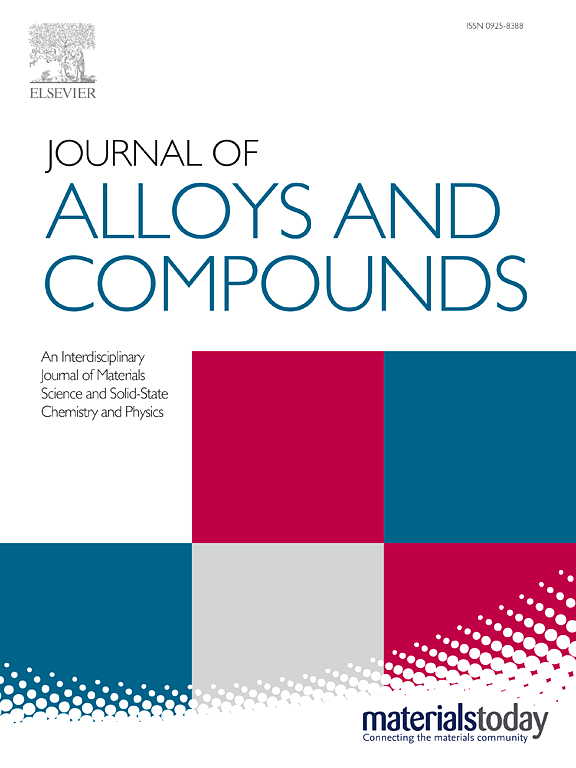Computation simulation and experiment investigations of stable co-doping perovskite solar cells with TiO2/SnO2 bilayer and CuSCN structures
IF 5.8
2区 材料科学
Q2 CHEMISTRY, PHYSICAL
引用次数: 0
Abstract
The charge transport layers play a momentous role in facilitating the extraction and injection of carriers in perovskite solar cells (PSCs). Unfortunately, the performance of PSCs fabricated with conventional charge transport materials exhibits significant hysteresis and instability. Here we utilise the composite TiO₂/SnO₂ with superior electron mobility and stability and the low-cost CuSCN as bilayer electron transport layer (ETL) and hole transport layer (HTL) materials, respectively. The PSCs with the p-n-n (p-type FAxMA1-xPbIxBryCl3-x-y (FA=CH(NH2)2), MA=CH3NH3)-n-type SnO2-n-type TiO2) construction of FTO/TiO2/SnO2/FAxMA1-xPbIxBryCl3-x-y/CuSCN/C/FTO have been investigated via the computation simulation and experiment. It has been observed that the PSCs performance of p-n-n structure surpasses that of n-n-p (n-type SnO2-n-type TiO2-p-type FAxMA1-xPbIxBryCl3-x-y) structure, benefiting from the existence of the bilayer ETL with p-n-n structure, which improves the collection ability, and the lifetime and mobility of photogenerated carriers. The perovskite thin film can be uniformly covered by the CuSCN HTL with 25 μL CuSCN drop-coating solution, which effectively reducing the hysteresis of the device under the atmosphere conditions during the experiment. Furthermore, we further demonstrate that the thickness of functional layers, conduction band offset, doping concentration, and operating temperature play crucial roles in determining the photophysical and photoelectric properties of PSCs. The simulation results imply that the PSCs we designed and optimized not only have high power conversion efficiency (PCE) (17.7619%) at 295 K but also maintain ascendant stability. This work shall provide up an effective strategy for the realization of high efficiency and long-term stable carbon-based PSCs.具有TiO2/SnO2双层和CuSCN结构的稳定共掺杂钙钛矿太阳能电池的计算模拟和实验研究
在钙钛矿太阳能电池中,电荷传输层对载流子的提取和注入起着重要的作用。不幸的是,用传统的电荷输运材料制备的PSCs表现出明显的滞后和不稳定性。本文利用具有优异电子迁移率和稳定性的tio_2 / sno_2复合材料和低成本的CuSCN分别作为双层电子传输层(ETL)和空穴传输层(HTL)材料。通过计算模拟和实验研究了p-n-n (p-type FAxMA1-xPbIxBryCl3-x-y (FA=CH(NH2)2), MA=CH3NH3)-n-type SnO2-n-type TiO2)结构FTO/TiO2/SnO2/FAxMA1-xPbIxBryCl3-x-y/CuSCN/C/FTO的PSCs。研究发现,p-n-n结构的PSCs性能优于n-n-p (n型sno2 -n型tio2 -p型FAxMA1-xPbIxBryCl3-x-y)结构,这得益于具有p-n-n结构的双层ETL的存在,提高了光生载流子的收集能力、寿命和迁移率。用25 μL CuSCN滴涂液均匀覆盖钙钛矿薄膜,有效降低了实验过程中器件在大气条件下的迟滞。此外,我们进一步证明了功能层厚度、导带偏移、掺杂浓度和工作温度对psc的光物理和光电性能起着至关重要的作用。仿真结果表明,我们设计和优化的PSCs在295 K时具有较高的功率转换效率(PCE)(17.7619%),并且保持上升稳定性。这项工作将为实现高效、长期稳定的碳基PSCs提供有效的策略。
本文章由计算机程序翻译,如有差异,请以英文原文为准。
求助全文
约1分钟内获得全文
求助全文
来源期刊

Journal of Alloys and Compounds
工程技术-材料科学:综合
CiteScore
11.10
自引率
14.50%
发文量
5146
审稿时长
67 days
期刊介绍:
The Journal of Alloys and Compounds is intended to serve as an international medium for the publication of work on solid materials comprising compounds as well as alloys. Its great strength lies in the diversity of discipline which it encompasses, drawing together results from materials science, solid-state chemistry and physics.
 求助内容:
求助内容: 应助结果提醒方式:
应助结果提醒方式:


